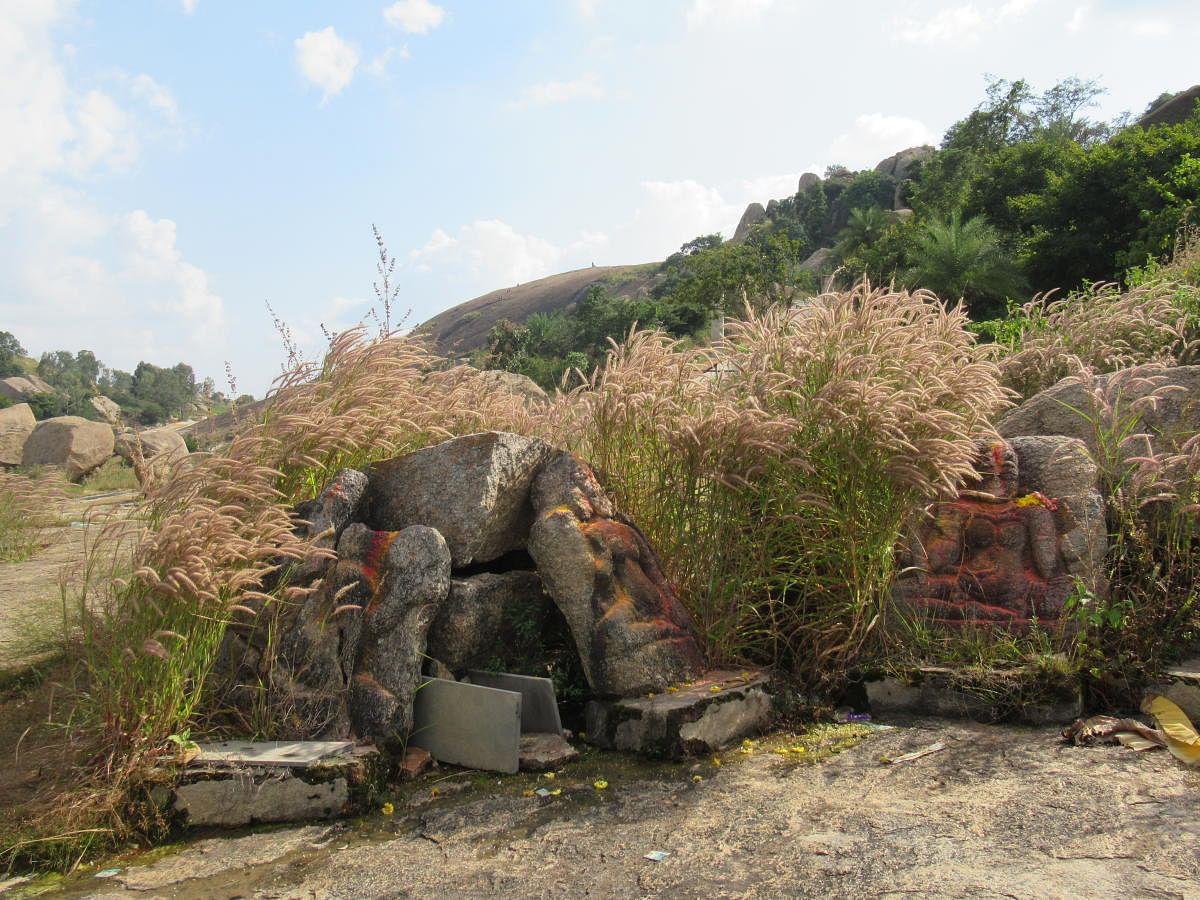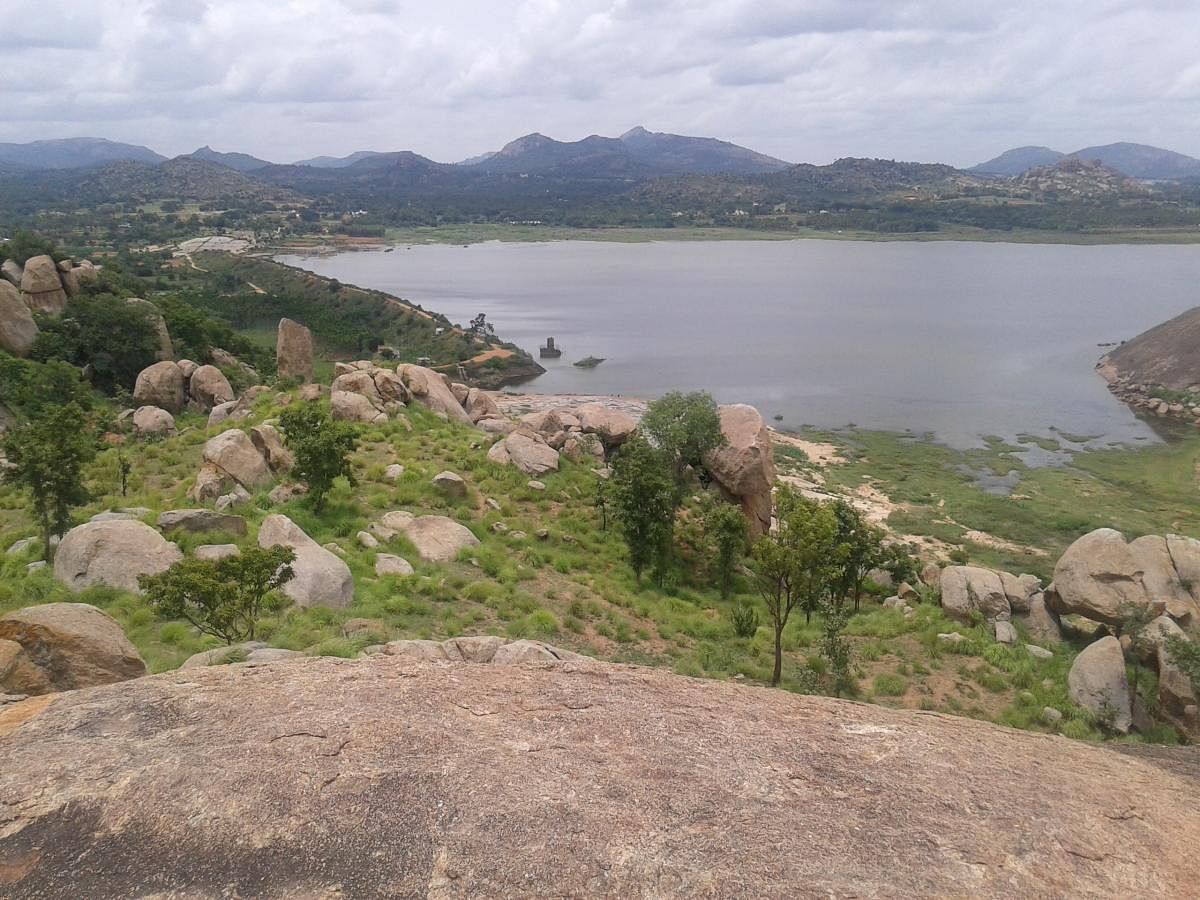
While sitting just behind the driver’s seat in a KSRTC bus en route Tumakuru, I was intrigued by a wide patch of white paint on a hill, between Hirehalli and Kyathasandra.
On my return journey the same afternoon, I decided to explore the captivating hill, also known as Basadi betta. It was post noon on a working day and the entire place, constructed a decade back, hardly had any sign of other humans.
As I made my way towards the hills, I saw that the white patch that I had spotted, was in fact, painted steps carved out from a monolithic surface. A quick climb to the top of the hill brought me to an ancient Jain temple complex. Walking around the fort-like walls revealed many boulders scattered on all sides of the hill, some painted with animal figures.
Entrance to temple
While trying to locate the entrance to the temple complex, I moved around the top of the hill and observed beautiful old paintings of tirthankaras (spiritual leaders in Jainism) on all sides of the enclosure walls. On the back wall, framed by two pillars with elephant carvings at the base and lotus at the top, stood a painted tirthankara. This appeared to be the original entrance.
Inside were four small ancient basadis (Jain temples) in a row and the fifth structure with a stupa stood a little away from the rest. The first basadi was empty but the remaining three housed Parshvanatha, Suparshvanatha and Chandraprabha Tirthankaras.
The fifth structure had ‘footprints’ on a stone slab and was dedicated to ‘1008 Sri Mahavira Tirthankararu’. The tall manastambha was of recent construction. The temple complex is popularly known as Mandaragiri. It is also called Basadi betta — a hill that houses Jain temples.
Maidala kere
At the back of the hill were big boulders. As I hopped from a small boulder onto a bigger one, a huge lake called ‘Maidala kere’, at the base of a neighbouring hill, became clearly visible. There was also a small mud path made by the movement of farmers and their cattle. It appeared to be a natural lake.
Could this be the ‘Maidavolala Divya Thirtha’ and the neighbouring hill the ‘Thirthada betta’, mentioned in an inscription stone I found in the temple complex?
Taking another round of the hill, I saw a beautiful small tank nestled in the rocks of the north-west of the temple complex. On the sloping surface towards this small lake, was a huge boulder with the image of a tirthankara slightly engraved and traced out in paint.
Nearby, there were two carved pillars fallen on the rock.
A dilapidated temple with a tirthankara carving was situated on the boulder. Climbing down led me to that stone mantap, with pillars in a ruined state. I was amazed to see a huge tirthankara carved onto the side of the boulder, though in a severely damaged state. What made the structure unique were the three lions at the base, with two more flanking the sides. A shadow of two elephants also remains at the base.
Padmavati kere
I could now see the huge Maidala kere to my right and the small tank in the rock bed to my left.
In my later visits to Mandaragiri, I found weathered and broken statues of eight goddesses in sitting posture, three feet in height, scattered in bushes at the edge of the Maidala kere. Groups of seven goddesses are usually referred to as Sapta Mathrikas or the divine mothers. As there were eight of them, they could be Ashta Mathrikas, a concept that exists.
Climbing up the hill, along its surface, instead of using the steps, gives me a sense of peace and rejuvenates my spirits. Of late, apart from the renovation of the top temple complex, a motorable road is being constructed.
